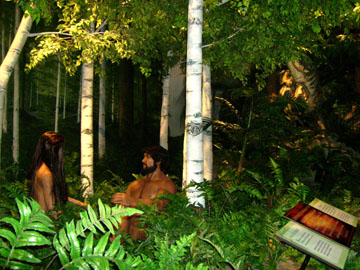 There has been much publicity about the new Creation Museum built by Answers in Genesis in northern Kentucky (greater Cincinnati). My wife and I decided to pay the museum a visit as part of a family vacation. We took the tour on May 29, 2007, the day after the Grand Opening. Despite continuing construction and a few incomplete exhibits, I can only describe the museum as impressive. The phrase from Jurassic Park, "spared no expense", kept coming to mind throughout the tour, and with all the animated dinosaurs, lush vegetation, and tropical sounds, it actually felt like a Jurassic Park!
There has been much publicity about the new Creation Museum built by Answers in Genesis in northern Kentucky (greater Cincinnati). My wife and I decided to pay the museum a visit as part of a family vacation. We took the tour on May 29, 2007, the day after the Grand Opening. Despite continuing construction and a few incomplete exhibits, I can only describe the museum as impressive. The phrase from Jurassic Park, "spared no expense", kept coming to mind throughout the tour, and with all the animated dinosaurs, lush vegetation, and tropical sounds, it actually felt like a Jurassic Park!
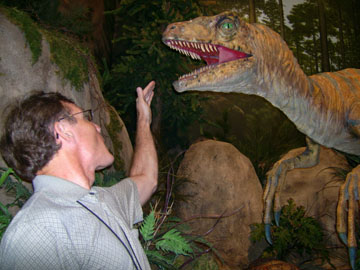 The museum is exquisitely designed and well choreographed. Visitors are led through a long sequence of exhibits interspersed with videos — some on screens among the exhibits and some in comfortable theaters. The exhibits are ordered by the "7 C's of History: Creation, Corruption, Catastrophe, Confusion, Christ, Cross, Consummation" (McKeever 2007) and have considerable diversity. The Dragon Theater, Special Effects Theater, and Stargazers' Planetarium are not part of the exhibit sequence and can be visited for scheduled presentations. The Special Effects Theater features vibrating chairs and splashes of water — during a presentation of Noah's Flood, of course.
The museum is exquisitely designed and well choreographed. Visitors are led through a long sequence of exhibits interspersed with videos — some on screens among the exhibits and some in comfortable theaters. The exhibits are ordered by the "7 C's of History: Creation, Corruption, Catastrophe, Confusion, Christ, Cross, Consummation" (McKeever 2007) and have considerable diversity. The Dragon Theater, Special Effects Theater, and Stargazers' Planetarium are not part of the exhibit sequence and can be visited for scheduled presentations. The Special Effects Theater features vibrating chairs and splashes of water — during a presentation of Noah's Flood, of course.
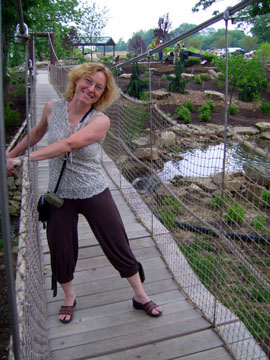 The exotic feel of the museum extends well beyond the exhibits and theaters. Noah's Café has the sounds and décor of a jungle and overlooks the lake outside, which has fountains and a variety of interesting bridges. The bookstore features a dragon theme. There are diverse activities and special exhibits for children. Visitors are photographed on their way into the museum and offered computerized prints with dinosaur backgrounds on their way out. The museum is full of helpful staff members wearing safari vests that read "Prepare to Believe". With a touch of humor, exhibits still under construction are labeled with signs that say "This Space is Still Evolving!" Photographs of the museum and its exhibits are available on the Web (AiG 2007; Lynn 2007), but hardly do it justice. The museum is well worth a half-day visit.
The exotic feel of the museum extends well beyond the exhibits and theaters. Noah's Café has the sounds and décor of a jungle and overlooks the lake outside, which has fountains and a variety of interesting bridges. The bookstore features a dragon theme. There are diverse activities and special exhibits for children. Visitors are photographed on their way into the museum and offered computerized prints with dinosaur backgrounds on their way out. The museum is full of helpful staff members wearing safari vests that read "Prepare to Believe". With a touch of humor, exhibits still under construction are labeled with signs that say "This Space is Still Evolving!" Photographs of the museum and its exhibits are available on the Web (AiG 2007; Lynn 2007), but hardly do it justice. The museum is well worth a half-day visit.
What is the message and presentation style of the Creation Museum? This is where things get interesting. First of all, Creation is only one of the "7 C's" presented in the museum. They all get extensive coverage, though Creation Week and Noah's Flood take center stage. The crowning event of the main tour is the Last Adam Theater where the gory details of Jesus's crucifixion are vividly portrayed — all to offset the sin committed in the Garden of Eden by Adam and Eve presented earlier. Visitors are encouraged to discuss this Christian message with trained staff members as they exit the theater. Perhaps a more appropriate name would be the Christian Museum.
Which creationism?
As a close follower of young-earth creationism, I was curious about many subtle aspects of the presentation. Most observers are hardly aware of the striking conflicts among creationists, both in terms of their beliefs and their presentation styles. The Creation Museum is the brainchild of Ken Ham, founder and president of Answers in Genesis USA and author of such books as The Lie: Evolution and The Great Dinosaur Mystery Solved (Ham 1987, 2000). Ham has a radio program called Answers with Ken Ham devoted to mocking evolution and "millions of years" with simplistic logic and innuendo — blaming these beliefs for social ills such as racism, drugs, and pornography. At first I expected the tone of the museum to fully reflect Ham's negative propaganda style.
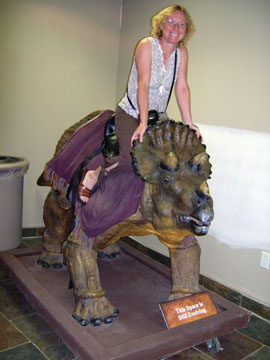 However, I was pleased to learn that Kurt Wise — a less propaganda-oriented creationist — was hired as a scientific consultant for the museum and played a major role in designing the exhibits. Kurt Wise and I were both graduate students under Stephen Jay Gould, and we have remained friends over the years despite our different perspectives. Richard Dawkins (2001) singled Wise out as "an honest creationist," willing to admit when scientific evidence does not weigh in his favor. Wise despises evolution bashing and avoids most aspects of apologetics. His books (Wise 2002, Wise and Richardson 2004) simply lay out the Christian story and seek to build historical models that incorporate both scriptural and scientific data. Wise shuns the limelight that Ham thrives in. The common thread that links Ham and Wise is an absolute belief in biblical accuracy and authority. For example, both accept the Genesis account of animals' and humans' being created on Day Six of creation week, so both have concluded that dinosaurs and humans co-existed on earth — a conclusion prominently displayed throughout the Creation Museum. But beyond this biblical worldview they have little in common.
However, I was pleased to learn that Kurt Wise — a less propaganda-oriented creationist — was hired as a scientific consultant for the museum and played a major role in designing the exhibits. Kurt Wise and I were both graduate students under Stephen Jay Gould, and we have remained friends over the years despite our different perspectives. Richard Dawkins (2001) singled Wise out as "an honest creationist," willing to admit when scientific evidence does not weigh in his favor. Wise despises evolution bashing and avoids most aspects of apologetics. His books (Wise 2002, Wise and Richardson 2004) simply lay out the Christian story and seek to build historical models that incorporate both scriptural and scientific data. Wise shuns the limelight that Ham thrives in. The common thread that links Ham and Wise is an absolute belief in biblical accuracy and authority. For example, both accept the Genesis account of animals' and humans' being created on Day Six of creation week, so both have concluded that dinosaurs and humans co-existed on earth — a conclusion prominently displayed throughout the Creation Museum. But beyond this biblical worldview they have little in common.
Kurt Wise's contribution to the museum is easy to recognize. A major theme of the exhibits is introduced in the Dinosaur Dig Site diorama near the beginning of the tour. Two paleontologists are excavating together as colleagues, and each explains how his "starting point" determines his interpretation of the fossils. One begins with "Human Reason" and believes in long ages of fossil deposition; the other begins with "God's Word" and believes the fossils formed quickly in Noah's Flood. The two perspectives are presented as equals with no test for evaluating them (not yet, at least). One observer commented: "Here I was very surprised. The museum, so far, does not seem as militant as I was expecting. This exhibit does not say that creationism is the correct choice (where, obviously, it must be — this is the Creation Museum), but instead seems to be trying to only allow creationism to be equal to evolution" (Lynn 2007). This respectful contrast continues in a series of exhibits on fossilization and the history of life. For example, a diagram of the "Evolution Tree" shows common ancestry for all living things, whereas the "Creation Orchard" shows diversification within a number of separately-created "kinds". The contrast between the old-earth/evolution and young-earth/creationist viewpoints continues, in various forms, through all the science-oriented exhibits. Creationism is thereby presented as a legitimate alternative science rather than a non-science or anti-science perspective. This represents a simple but powerful harmony for those trying to reconcile Christian doctrine with science.
What likely escapes even the most sympathetic visitors is the modernness of the creationist theories being presented in the museum. Elsewhere I have summarized the latest historical modeling by young-earth creationists (Heaton 2007). The museum presents no history of creationist thinking — only the latest conclusions of prominent young-earth model builders. For example, the old notion of special creation of species is never mentioned anywhere in the museum. Ironically, while creationists tend to disparage Charles Darwin, they have fully accepted the primary conclusion of his Origin of Species: that similar species are related and have a common ancestor. Modern creationists simply put limits on how far evolution can go in a young-earth timeframe. This allows them to accept the undeniable evidence for microevolution while dismissing macroevolution. An entire creationist society (the Baraminology Study Group) has emerged to work out the boundaries between the Genesis "kinds" (baramins), but these creationists and their efforts are not mentioned at the museum (see RNCSE 2006 Jul/Aug; 26 [4] for several articles on "baraminology"). Only a general outline of their perspective is illustrated.
Other modern efforts by creationists exhibited in the museum include Catastrophic Plate Tectonics, the rapid formation of coal, the post-Flood ice age, and the carving of the Grand Canyon by the catastrophic draining of post-Flood lakes. Once again the theorists and the history of their research are not covered, but only a general outline of their conclusions. I was disappointed that the pros and cons of these models are not developed in the museum as they are (to some degree) in the creationist literature (see Wise 2002). I got the impression that the scientific aspects were being downplayed compared to the larger Christian story. However, Wise informed me of delays in several scientific videos that are yet to come on line, so this part of the museum may be expanded. One video currently online includes an interview with creationist Michael Oard discussing his modeling of the post-Flood ice age. The museum fails to acknowledge that Oard is an ardent critic of the Catastrophic Plate Tectonics model, exhibited just a few feet away. Creationism is presented as standardized doctrine worthy of uniform acceptance throughout the museum, while in reality this is hardly so. Creationists hold radically divergent views on basic factual issues, such as which rock layers were deposited by Noah's Flood.
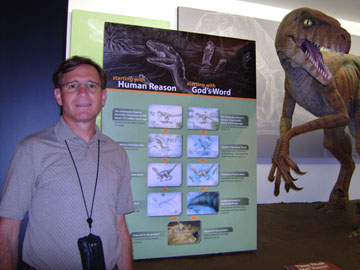 Balanced treatment?
Balanced treatment?
Are the scientific merits of creationism and evolution presented fairly in the museum? This is perhaps the most important but also the most complicated question to answer. Science and its underlying assumptions can be addressed at many levels. At the most basic philosophical level, science makes assumptions that deserve questioning, and supernatural intervention is within the scope of philosophical consideration. But the exhibits of the Creation Museum are not aimed at science's philosophical assumptions but at its empirical successes. The comparative results of "Human Reason" and "God's Word" presented in the museum in no way meet the same scientific standards. Young-earth creation models are a hodge-podge of religious and scientific components judged mainly by scripture. The model presented in the museum includes familiar scientific elements such as microevolution, plate tectonics, and an ice age (not mentioned in the Bible, but not contradicting it), while other equally well-established scientific conclusions such as the Big Bang, the antiquity of the earth, and the close relationship between humans and apes are rejected simply because they cannot be harmonized with a literal reading of Genesis. This is a biblical worldview with a few scientific elements thrown in for show. The creation model presented in the museum represents a reconciliation that holds true to the Bible, but this does not mean that the fit is good or that the conglomeration is scientific. In the primary literature some creationists have willingly admitted the scientific drawbacks of their models (see Heaton 2007; Wise 2002), but the museum presents creationism as a fully developed, unified model that covers all the scientific and scriptural evidence. Untrained visitors will be deceived by this presentation. To be honest the museum needs to admit frankly that creationism is not scientific and that its attempts to incorporate scientific findings are meager at best.
Despite the portrayal of the creationist and evolutionary models as equal scientific alternatives throughout the museum exhibits, there are subtle suggestions that creationism holds a better fit with the data. For example, in an exhibit on coal formation, the "problem" of clay layers within the coal is mentioned, and visitors are told that the young-earth model has a simple explanation for this while the old-earth model does not. The proposed explanation for the clay is not provided, nor is the reported "problem" for the old-earth model. In reality the same explanation, such as a storm with turbid runoff, would be adequate to explain the clay in either model.
Sleight-of-hand tricks of this type are far more egregious in other museum presentations, particularly the major video productions. For an extra fee visitors can watch a show in the Stargazers' Planetarium. This show includes an excellent presentation on the scale of the universe, including many recent astronomical findings, and light-years are used as the unit of measure. The show invites the question of how light could have traveled millions of light-years if the universe is only about 6000 years old. But visitors are assured that there are several simple explanations for how light could have traveled more quickly in the past and that many astronomical features, such as spiral galaxies and near-star Jupiter-like planets, cannot be explained by old-universe theories. In reality young-earth creationists have made no meaningful progress in resolving the starlight problem, and there is little agreement on the matter. One favorite explanation (as deceptive as it is ad hoc) is that God simply created the light en route to earth (Wise 2002: 64–5, 87). Creationists have no explanations of their own for astronomical objects other than "God made them," and creationist astronomy lags far behind creationist biology and geology in its development.
But even these attacks on conventional science pale in comparison with the show being presented in the museum's Special Effects Theater. This show is wildly comical and entertaining. It features a star-struck mannequin named Wendy sitting on stage by a campfire, alone in a desert wilderness, contemplating whether there might be a God. Two young men dressed as angels come flying in to take Wendy on a grand tour of creation and Christian history. These angels portray the voices of "evolution" and "millions of years" as evils sent to confuse people and lead them away from truth. They tell Wendy that radiometric dates are based on "assumptions" and therefore mean nothing. In a truly offensive scene the two angels (sans halos) appear as students in the back of a classroom where the teacher is trying to explain evolution using a slide show. The angels swap their own slides for his and proceed to harass the teacher at every turn. The teacher is portrayed as a dogmatic, bumbling idiot who holds to evolution despite all the evidence against it and cannot offer a coherent explanation to save his life. Incidentally, Answers in Genesis has published and is heavily promoting a new book called Evolution Exposed: Your Evolution Answer Book for the Classroom (Patterson 2006). This book, which is sold in the museum, encourages high school students to interrupt and challenge their teachers if evolution or an ancient earth is taught, and it provides them with copious ammunition. The museum's special effects show appears to be a demonstration of how students are to implement this aggressive, disrespectful behavior.
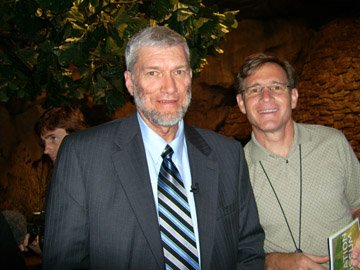 It is hard to miss the schizophrenia going on at the Creation Museum in terms of its presentation style. Kurt Wise informed me that these materials were created prior to his involvement and that the museum is trying to obtain the video masters in order to edit out the offensive material. But is Ken Ham ready to give up his attacks on evolution? By a stroke of luck we got a partial answer to this question. In our tour of the exhibits — with the most impressive animated dinosaur as a backdrop — we ran into Ken Ham himself giving a filmed interview. As we arrived he was praising Kurt Wise, telling the interviewer that the designer of the exhibits was trained at Harvard University by the eminent evolutionist Stephen Jay Gould. But the thrust of his message was that the museum is honest and balanced in its treatment of the two sides of the creationism/evolution debate and that evolution is treated fairly and respectfully. He emphasized that it is the underlying assumptions that lead a person to one side or the other. His only adversarial comments were that scientists refuse to admit their own assumptions and that several groups had opposed the opening of the museum because they were afraid to have the creation story told. But this was a far cry from the Ken Ham I have heard bashing evolution over the radio. When the interview ended I introduced myself to Ham, and my wife snapped a photo. When I mentioned that I was a friend of Kurt Wise, he seemed pleased and pointed me toward the exhibits on earth history that Wise had designed. Whether Ham will change his tune in a significant way remains to be seen.
It is hard to miss the schizophrenia going on at the Creation Museum in terms of its presentation style. Kurt Wise informed me that these materials were created prior to his involvement and that the museum is trying to obtain the video masters in order to edit out the offensive material. But is Ken Ham ready to give up his attacks on evolution? By a stroke of luck we got a partial answer to this question. In our tour of the exhibits — with the most impressive animated dinosaur as a backdrop — we ran into Ken Ham himself giving a filmed interview. As we arrived he was praising Kurt Wise, telling the interviewer that the designer of the exhibits was trained at Harvard University by the eminent evolutionist Stephen Jay Gould. But the thrust of his message was that the museum is honest and balanced in its treatment of the two sides of the creationism/evolution debate and that evolution is treated fairly and respectfully. He emphasized that it is the underlying assumptions that lead a person to one side or the other. His only adversarial comments were that scientists refuse to admit their own assumptions and that several groups had opposed the opening of the museum because they were afraid to have the creation story told. But this was a far cry from the Ken Ham I have heard bashing evolution over the radio. When the interview ended I introduced myself to Ham, and my wife snapped a photo. When I mentioned that I was a friend of Kurt Wise, he seemed pleased and pointed me toward the exhibits on earth history that Wise had designed. Whether Ham will change his tune in a significant way remains to be seen.
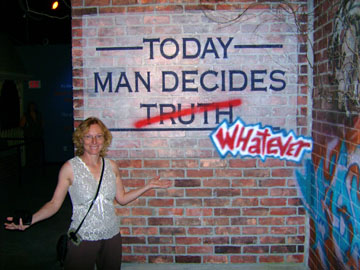 During my tour I tried to determine what group or groups of people the museum was designed to influence. I found little that would appeal to the sentiments of non-Christians or to committed scientists. Perhaps more significantly, there is nothing that would appeal to Christians that are already committed to old-age or allegorical interpretations of Genesis. In fact the museum exhibits and videos never admit the existence of popular Christian reconciliations with science, such as theistic evolution, progressive creation, and the day-age theory. Instead the museum contrasts only the extremes of biblical literalism and atheistic science. This appears to be a deliberate device to force visitors to accept one extreme or the other. Since the vast majority of visitors is likely to lean toward creationism, this approach will probably be quite effective. The museum is definitely designed to bolster the faith of conservative Christians and lead them to believe that young-earth creationism is in perfect harmony with the facts of modern science. The museum seems especially designed to dissuade those visitors that think they can believe both in Christianity and an old earth. The evil of "compromise" is explained in a section of the exhibits called Graffiti Alley and Culture in Conflict. In these dark, dingy rooms the evils of society are blamed on the acceptance of worldly view by many Christians. One of the statistics mentioned is that only half of Christian pastors accept "absolutes". To clinch the blame for this compromise, a giant wrecking ball labeled "100 Million Years" is shown demolishing a church. From this gloomy corner of the museum visitors are led through a starry tunnel into a bright theater where the six literal days of creation are read from Genesis, together with vibrant video and sound.
During my tour I tried to determine what group or groups of people the museum was designed to influence. I found little that would appeal to the sentiments of non-Christians or to committed scientists. Perhaps more significantly, there is nothing that would appeal to Christians that are already committed to old-age or allegorical interpretations of Genesis. In fact the museum exhibits and videos never admit the existence of popular Christian reconciliations with science, such as theistic evolution, progressive creation, and the day-age theory. Instead the museum contrasts only the extremes of biblical literalism and atheistic science. This appears to be a deliberate device to force visitors to accept one extreme or the other. Since the vast majority of visitors is likely to lean toward creationism, this approach will probably be quite effective. The museum is definitely designed to bolster the faith of conservative Christians and lead them to believe that young-earth creationism is in perfect harmony with the facts of modern science. The museum seems especially designed to dissuade those visitors that think they can believe both in Christianity and an old earth. The evil of "compromise" is explained in a section of the exhibits called Graffiti Alley and Culture in Conflict. In these dark, dingy rooms the evils of society are blamed on the acceptance of worldly view by many Christians. One of the statistics mentioned is that only half of Christian pastors accept "absolutes". To clinch the blame for this compromise, a giant wrecking ball labeled "100 Million Years" is shown demolishing a church. From this gloomy corner of the museum visitors are led through a starry tunnel into a bright theater where the six literal days of creation are read from Genesis, together with vibrant video and sound.
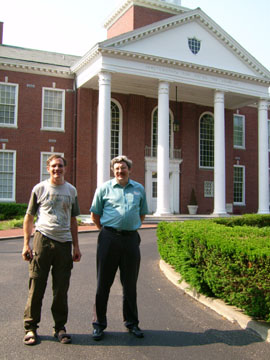 I found it hard to leave the museum because there was so much to see and absorb. But the experience was not over because I had arranged to visit Kurt Wise, whom we met at his new post at Southern Seminary in Louisville, just a hundred miles from the museum. We spent an enjoyable evening with Kurt and his wife discussing the museum and reminiscing about our days at Harvard. When I told Kurt that Ham had lauded his credentials, he wagged his head in disapproval but explained how he hoped he had made a positive impact. He seemed a bit conflicted about the museum and his involvement with it. Kurt's faith is so sound that he feels no need to bolster it by convincing others. He loves science and wants to find a harmony that remains true to his strict belief in scripture. But he is perfectly at ease letting others believe as they see fit. The museum was an opportunity and a frustration for him: an opportunity to put more honesty and respect into creationism, but a frustration because he had to compromise with a propaganda machine that he dislikes. Had it not been for Kurt's stories and explanations the museum experience might have remained a puzzle, but now the museum's schizophrenia makes perfect sense. While I remain merely a curious observer of young-earth creationism, I can only applaud Kurt's efforts and hope his approach wins the day.
I found it hard to leave the museum because there was so much to see and absorb. But the experience was not over because I had arranged to visit Kurt Wise, whom we met at his new post at Southern Seminary in Louisville, just a hundred miles from the museum. We spent an enjoyable evening with Kurt and his wife discussing the museum and reminiscing about our days at Harvard. When I told Kurt that Ham had lauded his credentials, he wagged his head in disapproval but explained how he hoped he had made a positive impact. He seemed a bit conflicted about the museum and his involvement with it. Kurt's faith is so sound that he feels no need to bolster it by convincing others. He loves science and wants to find a harmony that remains true to his strict belief in scripture. But he is perfectly at ease letting others believe as they see fit. The museum was an opportunity and a frustration for him: an opportunity to put more honesty and respect into creationism, but a frustration because he had to compromise with a propaganda machine that he dislikes. Had it not been for Kurt's stories and explanations the museum experience might have remained a puzzle, but now the museum's schizophrenia makes perfect sense. While I remain merely a curious observer of young-earth creationism, I can only applaud Kurt's efforts and hope his approach wins the day.
Reports of the National Center for Science Education
Volume
27
No.
1-2
January-April
2007
A Visit to the New Creation "Museum"
This version might differ slightly from the print publication.
